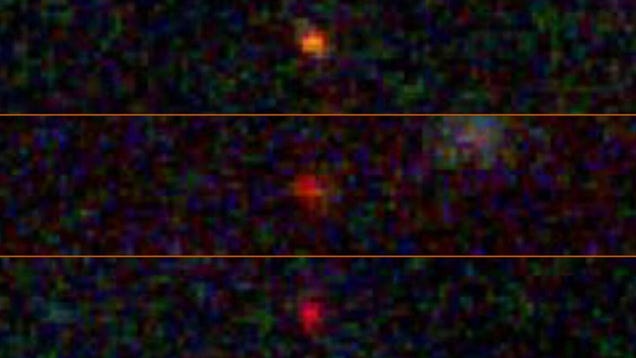Astronomers looking at ancient light seen by the Webb Space Telescope have found three pinpricks that they think could be “dark stars,” theoretical objects powered by dark matter.
Dark matter makes up about 27% of the universe; its partner in ambiguity, dark energy, makes up about 68%. You can do the math: we know stunningly little of what makes up the universe and how it behaves. It’s in that zone of cosmic uncertainty that Webb’s latest targets pop up. The team’s research was published last week in Proceedings of the National Academy of Sciences.
The three targets are JADES-GS-z13-0, JADES-GS-z12-0, and JADES-GS-z11-0, and were identified as galaxies by Webb back in December 2022. The targets were imaged as part of the JWST Advanced Deep Extragalactic Survey (JADES), which takes deep field images of space, looking at extremely ancient light to help scientists understand the evolution of cosmic structures like galaxies.
The three objects date to when the universe was between 320 million and 400 million years old, making them quite young (in a cosmic sense). And while they could well be galaxies containing millions of stars, the recent research team posits that they are never-before-seen dark stars, which could be millions of times the mass of our Sun and would be powered by the collisions of dark matter particles, rather than nuclear fusion.
Dark matter is not literally dark, at least not necessarily. It is called dark matter because it is nearly impossible for humans to detect. We see dark matter in its gravitational effects; haloes of dark matter glom galaxies together, and astronomers see ancient light more clearly when dark matter bends and focuses the photons transiting its gravitational field.
While scientists don’t know what makes up dark matter, they have a few ideas. As Gizmodo reported earlier this year:
There are a couple leading candidates for dark matter (and it’s not a zero-sum game; multiple candidates could be contributing to the dark matter in the universe). Weakly Interacting Massive Particles (WIMPs) are theoretical things that have mass and behave like particles but only interact barely with ordinary matter—hence our inability to identify them. The other major candidate is the axion, a theoretical particle (a boson, to be specific) named for a laundry detergent. The axion would be much smaller than a WIMP and has been theorized to behave more like a wave than a particle, like photons of light.
In April, a group of scientists studying Einstein rings (distant light that is strongly gravitationally lensed, creating a ring of light in space) found evidence that axionic dark matter is producing brightness anomalies in distant quasars.
But since dark matter candidates are not mutually exclusive, WIMPs could still well exist, and the recent research team suspects WIMPs are at the heart of theoretical dark stars. The idea is that WIMPs at the cores of dark stars collide, annihilating one another and releasing heat energy. That heat is released into hydrogen gas, making the objects shine brightly.
“Discovering a new type of star is pretty interesting all by itself, but discovering it’s dark matter that’s powering this—that would be huge,” said Katherine Freese, an astrophysicist at the University of Texas at Austin and the study’s co-author, in a university release. “If some of these objects that look like early galaxies are actually dark stars, the simulations of galaxy formation agree better with observations.”
Dark stars were first proposed in 2008, but only now is the Webb Space Telescope offering clear views of some of the most ancient light we can see. The theorized stars would be cool, puffy, and up to ten billion times the luminosity of the Sun, according to the research team.
Zany structures in space are described by astrophysicists from time to time, to provide mathematically described solutions for aspects of astrophysics that don’t completely make sense under the Standard Model of Cosmology. (The same could be said for different dark matter candidates, like axions, which were concocted to explain problems with the Standard Model of Particle Physics.)
Earlier this year, a team of physicists described a topological soliton, which would look like a black hole due to its gravitational effects but would still emit light. Boson stars and gravastars are examples of other objects that have been proposed mathematically but never observed.
In the same way, known objects are considered possible venues of dark matter production. In 2021, a team of astrophysicists suggested that axions may be produced at the cores of neutron stars, some of the universe’s densest objects. You can think of dark stars in the reverse: instead of their centres being factories for dark matter particles, they’re venues for their destruction.
The research team believes that dark stars could be misconstrued as large galaxies, and that the stars may seed the supermassive black holes seen even in the universe’s early days—which is to say, the first few hundred million years of its existence.
Some of those supermassive black holes may also be at play in the gravitational wave background, which astrophysicists saw the first signs of last month. As supermassive black holes orbit one another on the scale of hundreds of millions of years, they cause almost imperceptible ripples in spacetime that bounce through the cosmos.
More observations with Webb will give astrophysicists a better look at those ancient sources of light; be they galaxies or stars powered by dark matter, we hopefully won’t be kept in the dark much longer.
